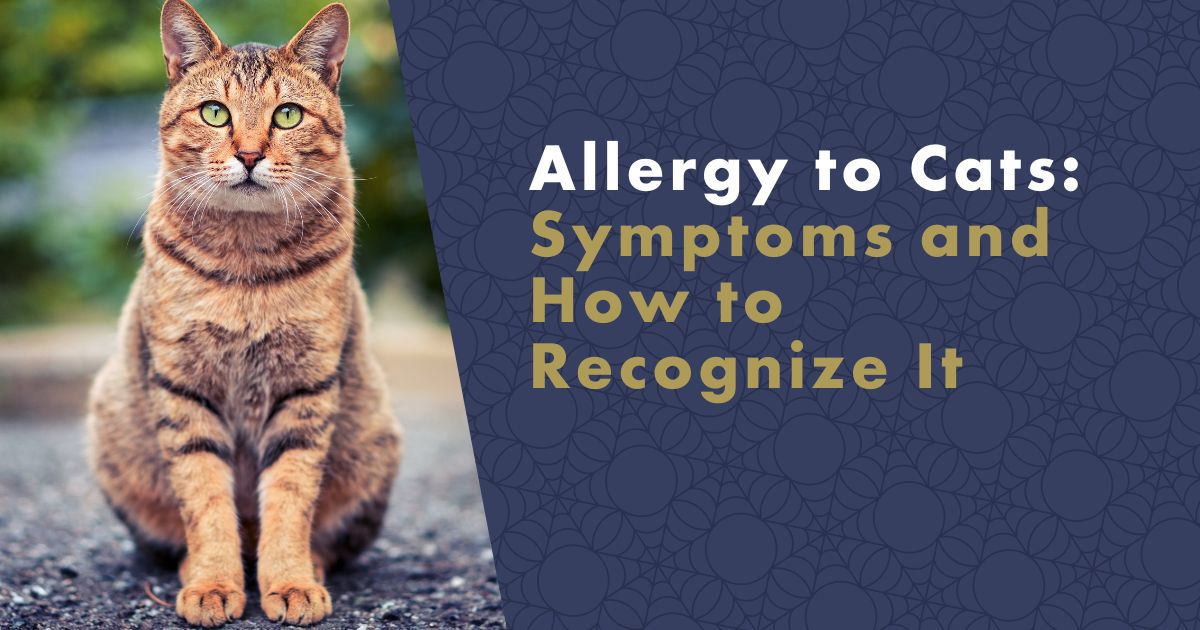Are you one of the increasing number of people worldwide suffering from cat allergies? Cat allergy is considered the third most common cause of respiratory allergies in humans. If you suspect you have a cat allergy or are looking for ways to alleviate allergic reactions without having to give away your beloved feline companion, you've come to the right place. Today, we will delve into what exactly causes allergic reactions, explore the symptoms of cat allergies, and examine the latest studies on the use of air purifiers and other measures that can alleviate the effects of cat allergens.

Unveiling Cat Allergies
Cat allergies stem from a particular protein found in a cat's saliva, urine, and skin. This culprit protein, known as Fel d 1, is primarily present in a cat's saliva, but can also be found in their urine and skin. When these microscopic particles come into contact with the noses, eyes, or lungs of susceptible individuals, the immune system goes into action, activating white blood cells. These cells release histamine, triggering inflammation and allergic symptoms such as sneezing, itching, and nasal congestion.
Identifying the Symptoms
Cat allergy symptoms can manifest in various ways, ranging from mild to severe. Some common signs of cat allergies include:
- Sneezing and Runny Nose: Frequent sneezing and a runny nose are classic indicators of an allergic reaction to cats.
- Nasal Itch and Irritation: Itchy nose, eyes, or throat can be persistent symptoms experienced by cat allergy sufferers.
- Sneezing and Coughing: Allergies to cats can provoke bouts of sneezing and persistent coughing.
- Watery Eyes: Excessive tearing, redness, and itching of the eyes are common allergic reactions to cats.
- Skin Rash: In some cases, direct contact with cat allergens can lead to skin rashes and irritation.
- Shortness of Breath: Severe cat allergies can cause difficulty breathing and exacerbate pre-existing asthma symptoms.
It is important to note that cats can also carry other allergens such as pollen and dust mites, so experiencing allergic reactions when petting a cat doesn't necessarily mean you're solely allergic to cats.
Diagnosing Cat Allergies
To diagnose cat allergies, dermatological or blood tests can be conducted. These tests help determine if you have an allergic reaction to cats. If you suspect you have a cat allergy, it is advisable to consult an allergist who can guide you through the diagnostic process.
How to Treat Cat Allergies and What Works?
The best approach to managing a cat allergy is to avoid exposure to the allergens altogether. If you have a cat and suffer from cat allergies, consider whether it would be possible for your cat to live exclusively outdoors. However, it's essential to note that confining the cat to a single room will not limit the allergens to that area alone. Cat allergens can easily spread throughout the house via clothing, carpets, and air circulation. When you interact with your cat, it's crucial to practice good hygiene to minimize allergic reactions. After petting your cat, always remember to thoroughly wash your hands with soap and water.
The treatment of cat allergies typically involves the following:
- Antihistamines
- Corticosteroids
- Immunotherapy
Specific symptoms can be targeted with the following approaches:
- Nasal Symptoms: Nasal corticosteroid sprays, oral antihistamines, or other oral medications can help alleviate nasal symptoms. Nasal irrigation can also provide relief by reducing allergic reactions.
- Eye Inflammation and Itching: Antihistamine eye drops are often used to treat eye symptoms associated with allergies.
- Respiratory or Asthmatic Symptoms: Inhalation corticosteroids or bronchodilators may be prescribed to prevent or relieve respiratory symptoms in individuals with asthma or breathing difficulties.
Immunotherapy tends to be the most effective because they gradually increase tolerance over time by injecting increasing doses of the allergen. But even this treatment is not 100% and everyone reacts to it differently.
Exciting developments in cat allergy research have introduced a novel solution: cat food enriched with immunoglobulins IgY against the Fel d 1 allergen. These immunoglobulins, derived from chicken eggs, neutralize Fel d 1 after its formation, inhibiting its immunogenic activity. This approach does not interfere with the overall production of Fel d 1 in cats, preserving their natural biological function. Studies have confirmed the effectiveness of anti-Fel d 1 IgY in combating cat allergies, both in laboratory settings and in cats fed with this specialized food. Research has shown up to a 30% reduction in Fel d 1 levels in cat saliva and a significant decrease in active Fel d 1 in cats fed this specific diet. Despite these promising results, such cat food is not yet available for purchase.

Living with a Cat Allergy: How to Coexist with Your Furry Friend
So, you have a cat allergy but still want to share your life with a feline companion? Fortunately, there are numerous ways to reduce the risk of allergic reactions. Here are some helpful tips:
- Create a Cat-Free Zone: Keep your bedroom off-limits to your furry friend, allowing you to rest at night free from cat allergens.
- Invest in Air Purifiers: Allergy-friendly air purifiers should be placed in various rooms to filter out allergens and improve air quality.
- Use Personal Air Purifiers: Consider using personal air purifiers when in direct contact with your cat to minimize allergen exposure.
- Embrace Robotic Vacuum Cleaners: Opt for a robotic vacuum cleaner that can effortlessly clean those hard-to-reach spots, including under furniture, where cat allergens tend to accumulate.
- Minimize Upholstery and Carpets: Reduce the amount of upholstery and carpets in your living space, as they trap cat allergens more easily.
- Regularly Bathe Your Cat: If possible, give your cat regular baths to help reduce the allergen load on their fur.
- Explore Immunotherapy and Medication: Consult your allergist about immunotherapy options and recommended medications that can help manage your symptoms effectively.
Preventing Cat Allergies in Children
Cat allergies in children are similar to those in adults, but there is a higher likelihood of experiencing allergic skin reactions, such as hives. Unfortunately, it is not possible to prevent the development of allergies in children, as cat allergies are largely hereditary.
Can an Air Purifier Help with Cat Allergies?
Yes, but even this measure has its limitations. According to a study, using an air purifier with a HEPA filter can help reduce the levels of Fel d 1 (the cat allergen) in the air. However, immediate effects should not be expected. The study revealed that Fel d 1 levels remained unchanged during the first 4 days of using an air purifier and only decreased after 4 days of continuous use. Subsequently, they gradually decreased to 33% of the original levels within 14 days.
Air purifiers can also benefit individuals with asthma who are allergic to cats. According to research, air purifiers significantly reduce early and late asthmatic reactions in patients with cat allergies. Compared to a placebo, the occurrence of reactions decreased by 58.3%, as demonstrated by the Cox model. Active air purifiers also reduced the maximum severity of bronchial reactions in patients. These findings support the use of air purifiers for allergy prevention in asthma patients affected by cat allergens.
How Does Cat Allergy Differ from Other Allergies?
Cat allergies share similar symptoms with allergies to dust and pollen. Therefore, it is important to visit an allergist to determine if you or your child may have allergies to substances other than cats before considering rehoming your feline companion. Cats are common carriers of pollen and dust particles, which can exacerbate allergies.
Frequently Asked Questions
Can Cat Allergies Disappear?
In some cases, it is possible for cat allergies to disappear. Allergies can change over time, especially in children. Immunotherapy also plays a significant role in the disappearance of allergies.
What Are the Most Effective Medications for Cat Allergies?
The most effective medications for cat allergies are antihistamines, which block the effects of histamine, the compound responsible for allergic symptoms.
Are There Cats that People Are Not Allergic to?
There are claims that certain cat breeds produce fewer allergens than others. Unfortunately, this is not true, as there is no scientific data to support such claims. The production of the allergen Fel d 1 varies among individual cats and is partly influenced by testosterone levels. Some cats may produce more Fel d 1, thus triggering stronger allergic reactions. In simple terms, all cats produce allergens, and studies have not proven the existence of hypoallergenic cats. Households with more than one cat have higher levels of cat allergens. Characteristics such as the length of cat fur, gender, or the amount of time spent indoors are not associated with cat allergen levels.
Is Allergen Immunotherapy an Option for Cat Allergies?
Yes, allergen immunotherapy is recommended for individuals with moderate to severe cat allergies, although it is not always 100% successful.
Is It Possible to Be Allergic to Cats but Not Other Animals?
Yes, it is possible to be allergic to cats and not to other animals, or vice versa. Each person may have a different allergic reaction to various animal species or allergens.
Learn more about allergies:
Sources
- Asher MI, Montefort S, Björkstén B, Lai CK, Strachan DP, Weiland SK, et al. Worldwide time trends in the prevalence of symptoms of asthma, allergic rhinoconjunctivitis, and eczema in childhood: ISAAC phases one and three repeat multi-country cross-sectional surveys. Lancet. 2006;368(9537):733–43.
- Bonnet B, Messaoudi K, Jacomet F, et al.. An update on molecular cat allergens: Fel d 1 and what else? Chapter 1: Fel d 1, the major cat allergen. Allergy Asthma Clin Immunol 2018; 14. DOI: 10.1186/s13223-018-0239-8.
- Baldacci, S., Maio, S., Cerrai, S., et al. (2015). Allergy and asthma: effects of the exposure to particulate matter and biological allergens. Respiratory Medicine, 109, 1089-1104.Custovic, A., Simpson, A., & Woodcock, A. (1998). Importance of indoor allergens in the induction of allergy and elicitation of allergic disease. Allergy, 53, 115-120.
- Galant, S., Berger, W., Gillman, S., et al. (1998). Prevalence of sensitization to aero-allergens in California patients with respiratory allergy. Annals of Allergy, Asthma & Immunology, 81, 203-210.
- Gherasim A, de Blay F. Does Air Filtration Work for Cat Allergen Exposure? Curr Allergy Asthma Rep. 2020 May 14;20(6):18. doi: 10.1007/s11882-020-00912-w. PMID: 32409912.
- Sly, R. M. (1999). Changing prevalence of allergic rhinitis and asthma. Annals of Allergy, Asthma & Immunology, 82, 233-248.
- Sparkes AH. Human allergy to cats: A review for veterinarians on prevalence, causes, symptoms and control. J Feline Med Surg. 2022 Jan;24(1):31-42. doi: 10.1177/1098612X211036793. Epub 2021 Oct 8. PMID: 34622710; PMCID: PMC8721530.
- Simpson A, Brough HA, Haider S, Belgrave D, Murray CS, Custovic A, et al. Early-life inhalant allergen exposure, filaggrin genotype and the development of sensitization from infancy to adolescence. J Allergy Clin Immunol. 2019;6749(19):31323–5. Fel d 1 exposure significantly increased the risk of sensitization among children with FLG mutations at different ages.
